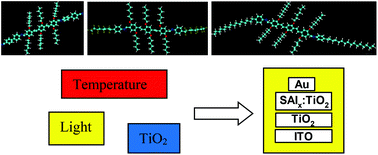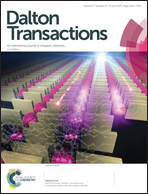Structural and electrochemical studies of TiO2 complexes with (4,4′-((1E,1′E)-(2,5-bis(octyloxy)-1,4-phenylene)bis(ethene-2,1-diyl))bis-(E)-N-(2,5-bis(octyloxy)benzylidene)) imine derivative bases towards organic devices†
Abstract
Three (4,4′-((1E,1′E)-(2,5-bis(octyloxy)-1,4-phenylene)bis(ethene-2,1-diyl))bis-(E)-N-(2,5-bis(octyloxy)benzylidene)) imine derivatives were synthesized via a condensation reaction with p-toluenesulfonic acid as a catalyst. The effects of the end groups and vinylene (–HC![[double bond, length as m-dash]](https://www.rsc.org/images/entities/char_e001.gif) CH–) moieties on the structural, thermal, optical, electrochemical and photovoltaic properties of imines were investigated to check the influence of TiO2 on the imine properties. The thermal behavior of imines and their complexes with TiO2 was widely investigated using FT-IR, XRD, DSC and POM methods in order to determine the order type in the imine structure. All imines present the highest occupied molecular orbital (HOMO) levels of about −5.39 eV (SAI1 and SAI2) and −5.27 eV (SAI3) and the lowest unoccupied molecular orbital (LUMO) levels at about −3.17 eV. The difference of the end groups in the imines in each case did not affect redox properties. Generally, both oxidation and reduction are easier after TiO2 addition and it also changes the HOMO–LUMO levels of imines. Moreover, changes in the characteristic bands for imines in the region 1500–1700 cm−1 observed as a drastic decrease of intensity or even disappearance of bands in the imine : TiO2 mixture suggest the formation of a complex (C
CH–) moieties on the structural, thermal, optical, electrochemical and photovoltaic properties of imines were investigated to check the influence of TiO2 on the imine properties. The thermal behavior of imines and their complexes with TiO2 was widely investigated using FT-IR, XRD, DSC and POM methods in order to determine the order type in the imine structure. All imines present the highest occupied molecular orbital (HOMO) levels of about −5.39 eV (SAI1 and SAI2) and −5.27 eV (SAI3) and the lowest unoccupied molecular orbital (LUMO) levels at about −3.17 eV. The difference of the end groups in the imines in each case did not affect redox properties. Generally, both oxidation and reduction are easier after TiO2 addition and it also changes the HOMO–LUMO levels of imines. Moreover, changes in the characteristic bands for imines in the region 1500–1700 cm−1 observed as a drastic decrease of intensity or even disappearance of bands in the imine : TiO2 mixture suggest the formation of a complex (C![[double bond, length as m-dash]](https://www.rsc.org/images/entities/char_e001.gif) N)–TiO2. Organic devices with the configuration of ITO/TiO2/SAIx (or SAIx : TiO2)/Au were fabricated and investigated in the presence and absence of visible light irradiation with an intensity of 93 mW cm−2. In all imines and complexes with TiO2, the generation of the photocurrent indicates their use as photodiodes and the best result was observed for SAI3 : TiO2 complexes.
N)–TiO2. Organic devices with the configuration of ITO/TiO2/SAIx (or SAIx : TiO2)/Au were fabricated and investigated in the presence and absence of visible light irradiation with an intensity of 93 mW cm−2. In all imines and complexes with TiO2, the generation of the photocurrent indicates their use as photodiodes and the best result was observed for SAI3 : TiO2 complexes.



 Please wait while we load your content...
Please wait while we load your content...